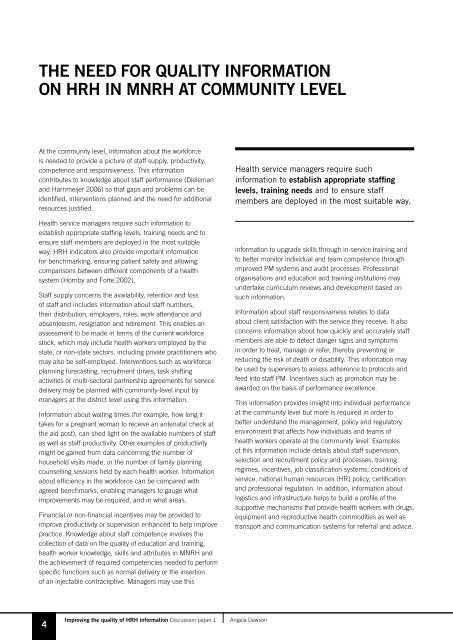improving the quality of hrh information - HRH Knowledge Hub ...
improving the quality of hrh information - HRH Knowledge Hub ...
improving the quality of hrh information - HRH Knowledge Hub ...
Create successful ePaper yourself
Turn your PDF publications into a flip-book with our unique Google optimized e-Paper software.
The need for <strong>quality</strong> <strong>information</strong><br />
on <strong>HRH</strong> in MNRH at community level<br />
At <strong>the</strong> community level, <strong>information</strong> about <strong>the</strong> workforce<br />
is needed to provide a picture <strong>of</strong> staff supply, productivity,<br />
competence and responsiveness. This <strong>information</strong><br />
contributes to knowledge about staff performance (Dieleman<br />
and Harnmeijer 2006) so that gaps and problems can be<br />
identified, interventions planned and <strong>the</strong> need for additional<br />
resources justified.<br />
Health service managers require such <strong>information</strong> to<br />
establish appropriate staffing levels, training needs and to<br />
ensure staff members are deployed in <strong>the</strong> most suitable<br />
way. <strong>HRH</strong> indicators also provide important <strong>information</strong><br />
for benchmarking, ensuring patient safety and allowing<br />
comparisons between different components <strong>of</strong> a health<br />
system (Hornby and Forte 2002).<br />
Staff supply concerns <strong>the</strong> availability, retention and loss<br />
<strong>of</strong> staff and includes <strong>information</strong> about staff numbers,<br />
<strong>the</strong>ir distribution, employers, roles, work attendance and<br />
absenteeism, resignation and retirement. This enables an<br />
assessment to be made in terms <strong>of</strong> <strong>the</strong> current workforce<br />
stock, which may include health workers employed by <strong>the</strong><br />
state, or non-state sectors, including private practitioners who<br />
may also be self-employed. Interventions such as workforce<br />
planning forecasting, recruitment drives, task shifting<br />
activities or multi-sectoral partnership agreements for service<br />
delivery may be planned with community-level input by<br />
managers at <strong>the</strong> district level using this <strong>information</strong>.<br />
Information about waiting times (for example, how long it<br />
takes for a pregnant woman to receive an antenatal check at<br />
<strong>the</strong> aid post), can shed light on <strong>the</strong> available numbers <strong>of</strong> staff<br />
as well as staff productivity. O<strong>the</strong>r examples <strong>of</strong> productivity<br />
might be gained from data concerning <strong>the</strong> number <strong>of</strong><br />
household visits made, or <strong>the</strong> number <strong>of</strong> family planning<br />
counselling sessions held by each health worker. Information<br />
about efficiency in <strong>the</strong> workforce can be compared with<br />
agreed benchmarks, enabling managers to gauge what<br />
improvements may be required, and in what areas.<br />
Financial or non-financial incentives may be provided to<br />
improve productivity or supervision enhanced to help improve<br />
practice. <strong>Knowledge</strong> about staff competence involves <strong>the</strong><br />
collection <strong>of</strong> data on <strong>the</strong> <strong>quality</strong> <strong>of</strong> education and training,<br />
health worker knowledge, skills and attributes in MNRH and<br />
<strong>the</strong> achievement <strong>of</strong> required competencies needed to perform<br />
specific functions such as normal delivery or <strong>the</strong> insertion<br />
<strong>of</strong> an injectable contraceptive. Managers may use this<br />
Health service managers require such<br />
<strong>information</strong> to establish appropriate staffing<br />
levels, training needs and to ensure staff<br />
members are deployed in <strong>the</strong> most suitable way.<br />
<strong>information</strong> to upgrade skills through in-service training and<br />
to better monitor individual and team competence through<br />
improved PM systems and audit processes. Pr<strong>of</strong>essional<br />
organisations and education and training institutions may<br />
undertake curriculum reviews and development based on<br />
such <strong>information</strong>.<br />
Information about staff responsiveness relates to data<br />
about client satisfaction with <strong>the</strong> service <strong>the</strong>y receive. It also<br />
concerns <strong>information</strong> about how quickly and accurately staff<br />
members are able to detect danger signs and symptoms<br />
in order to treat, manage or refer, <strong>the</strong>reby preventing or<br />
reducing <strong>the</strong> risk <strong>of</strong> death or disability. This <strong>information</strong> may<br />
be used by supervisors to assess adherence to protocols and<br />
feed into staff PM. Incentives such as promotion may be<br />
awarded on <strong>the</strong> basis <strong>of</strong> performance excellence.<br />
This <strong>information</strong> provides insight into individual performance<br />
at <strong>the</strong> community level but more is required in order to<br />
better understand <strong>the</strong> management, policy and regulatory<br />
environment that affects how individuals and teams <strong>of</strong><br />
health workers operate at <strong>the</strong> community level. Examples<br />
<strong>of</strong> this <strong>information</strong> include details about staff supervision,<br />
selection and recruitment policy and processes, training<br />
regimes, incentives, job classification systems, conditions <strong>of</strong><br />
service, national human resources (HR) policy, certification<br />
and pr<strong>of</strong>essional regulation. In addition, <strong>information</strong> about<br />
logistics and infrastructure helps to build a pr<strong>of</strong>ile <strong>of</strong> <strong>the</strong><br />
supportive mechanisms that provide health workers with drugs,<br />
equipment and reproductive health commodities as well as<br />
transport and communication systems for referral and advice.<br />
4<br />
Improving <strong>the</strong> <strong>quality</strong> <strong>of</strong> <strong>HRH</strong> <strong>information</strong> Discussion paper 1<br />
Angela Dawson

















